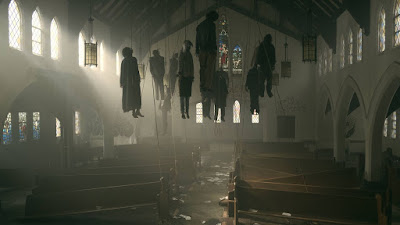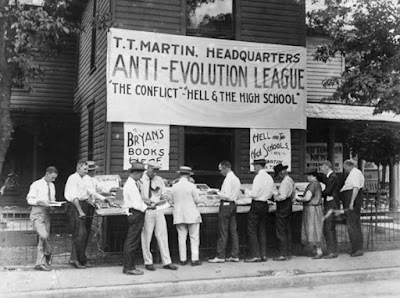 |
| Warning signs hang in a church in Hulu’s adaptation of The Handmaid’s Tale. Hulu | Vox |
Topics: Civics, Civil Rights, Existentialism, Fascism, Human Rights
Note: Taking a blog break as I prepare for midterms. I'll reemerge in about two weeks.
The Sons of Jacob are the conspiratorial group that devised the philosophy and social structure for a totalitarian patriarchal theocracy and orchestrated the rise of Gilead.
A founder of a local Sons of Jacob chapter tells the Boston Globe in an interview he read about the community in a Facebook group and got into it because he wanted to help "the kids" to "get them out of gangs and away from their sinful families and into a better way of [life]."
According to Offred, "'they' shot the president and machine-gunned the Congress, and the army declared a state of emergency". She adds "they blamed it on the Islamic fanatics" and that "the entire government" was "gone like that", making her wonder "how did 'they' get in". Later on "they suspended the Constitution" which they said "would be temporary". Moira suspects "they've been building up to this".
Source: The Sons of Jacob, The Handmaid's Tale Fandom Wiki
Margaret Atwood published The Handmaid's Tale in 1985. The Sons of Jacob didn't have Facebook or social media, so their emergence was from a fictionalized decline in birthrates that propelled them to act out of fear for survival. Being 1985, it would have never occurred to the writer to bring an outside force from Russia favoring the Sons of Jacob to assist them first electorally: we were in the Cold War and apparently still litigating the Civil War. The author pointed out in an interview, what seems sudden in a coup d'etat typically happens first in the background. Outside the awareness of the country, it suddenly overruns an unsuspecting public with a surprise assault.
Impeachment is not necessarily for a crime. He can be impeached for not fulfilling his presidential duties nominating candidates (preferring "acting" positions) for senate confirmation in their constitutional duty to "advise and consent" (obliterated by Moscow Mitch with respect to President Obama and Merrick Garland).
[The president] shall have Power, by and with the Advice and Consent of the Senate, to make Treaties, provided two thirds of the Senators present concur; and he shall nominate, and by and with the Advice and Consent of the Senate, shall appoint Ambassadors, other public Ministers and Consuls, Judges of the supreme Court, and all other Officers of the United States... Senate.gov
Now...Caligula tweets threats of civil war and witness intimidation, yet another ground for impeachment. Twenty-four hours after denying he strong-armed the Ukrainian president, did it AGAIN from the White House lawn, involving China. The fact he has a shot-in-foot trade war with them is bizarre, and the equivalent of falling on his own Sword of Damocles.
Public-opinion polling shows that Trump’s low opinion of American elections has practically become Republican Party orthodoxy. According to a Reuters/Ipsos poll released on Friday, Republicans have an “unprecedented” level of “concern and mistrust in the system.” Roughly 70 percent of Republican voters believe that if Hillary Clinton wins the election, it’ll be due to fraud. In both this poll and an NBC News/SurveyMonkey poll, only half of Republicans say they’d accept a Clinton victory. (In the latter poll, by contrast, 82 percent of Democrats said they would accept a Trump victory.)
This suspicious Republican electorate is joined by growing ranks of conservative politicians, pundits, and intellectuals. They’re all increasingly willing to say that the existing American political system is hopelessly flawed and needs to be rolled back to the days before blacks and women could vote. On the most obvious level, this can be seen in moves by Republican governors all over America to make voting more difficult, through stringent voting ID laws, new hurdles to registration, and the curtailment of early-voting options. Equally significant has been the gutting of key provisions of the Voting Rights Act by conservative Supreme Court justices in the 2013 Shelby Country v. Holder ruling.
But these overt forms of voting suppression are merely the most visible manifestations of a larger questioning of democracy on the political right. Trump’s anti-democratic rhetoric—and the eagerness of so many good, white patriotic Americans to cheer it and believe it—is a symptom of the larger trend on the political right toward doubting the legitimacy of the American system. The question we need to be asking isn’t, “Why is Trump being such a jerk?” It’s, “Why is the American Right giving up on democracy?”
The Right Is Giving Up on Democracy, Jeet Heer, New Republic, October 24, 2016
William Barr, the nation's top cop, isn't fighting the Opioid Crisis at home, but globetrotting after debunked conspiracy theories to link Ukraine to the DNC server hack, not Russia, therefore discrediting the Mueller Report and thus, justify lifting any sanctions against them. Rudy Giuliani - America's mayor after 9/11 - is passing around said debunked conspiracy theories in Trump hotel folders with monogrammed stationary. Mike Pompeo is denying unsuccessfully testimony to the House Intelligence Committee regarding his complicity in the Ukrainian call, which he eventually admitted being on. Mike Pompeo is a graduate of West Point. Mike Pompeo is a Harvard Law graduate. He's supposedly a "Christian" with a penchant for mendacity that is only eclipsed by Orange Satan.
At my previous job before graduate school, one of my coworkers was lamenting about the "birth rate decline of white people" right outside of my office. He had three children, the guy nodding next to him had FIVE and the next two gents two and three children respectively. For the record: I have two sons, a daughter-in-law; a granddaughter (not then). I clearly was outnumbered. White supremacy is if nothing, anxiously numerical.
I closed the door to my office. It wasn't worth a reply.
The Sons of Jacob are fictional, but the fear of "white genocide" is quite real and first retweeted by the Manchurian Candidate now at Pennsylvania Avenue.
The prospect of civil war was first opined by evangelical (evil-gelical) pastor Robert Jeffress, again retweeted by an addled, Internet addicted and disturbed mind. Franklin Graham can't recall a SINGLE lie told by the "father of lies." He made #Antichrist trend on Twitter after his self-apotheosis as "the chosen one." I guess such a figure needs anti-Christian followers in his flock, as neither remotely reminds me of Christ.
White Americans own a lot of guns, brought on by "fear of the other": demographically, evangelicals became numerical minorities in 2017. Some openly discuss the aspect of a modern civil war. One of my friends from undergraduate at NC A&T, said so. Working as a GS engineer for the US Navy, they openly discussed a race war with the only African American engineer in the division and the rounds of ammunition they purchased for the "Turner Diaries"-inspired bloodbath. My wife heard similar sentiments from her coworkers at her employment where she is also the only African American.
The impeachments of Andrew Johnson and Bill Clinton were successful in their respective House of Representatives only. Nixon seeing the biblical "handwriting on the wall," resigned before removal. Even with the mounting evidence, and if impeachment is successful for the first time in our history: If his removal is recommended by Moscow Mitch's senate, their constituent's collective pathology may be worth tearing our republic to bits over. I shudder over that apocalyptic scenario.
I'm not sure their blindness lets them see it: fascist sons of bitches erecting this bullshit mountain will not "make America great again," turn back the clock on climate change; make coal or petroleum clean, bring back factory and farm jobs, de-globalize the world economy, make women barefoot and perpetually pregnant, put black, brown and anyone other-than-white-people on the back of the bus, LGBT back in the closet or inaugurate a Dominionism-inspired Republic of Gilead.
In fiction, Moira suspected "they've been building up to this".
They are building us up to something...













